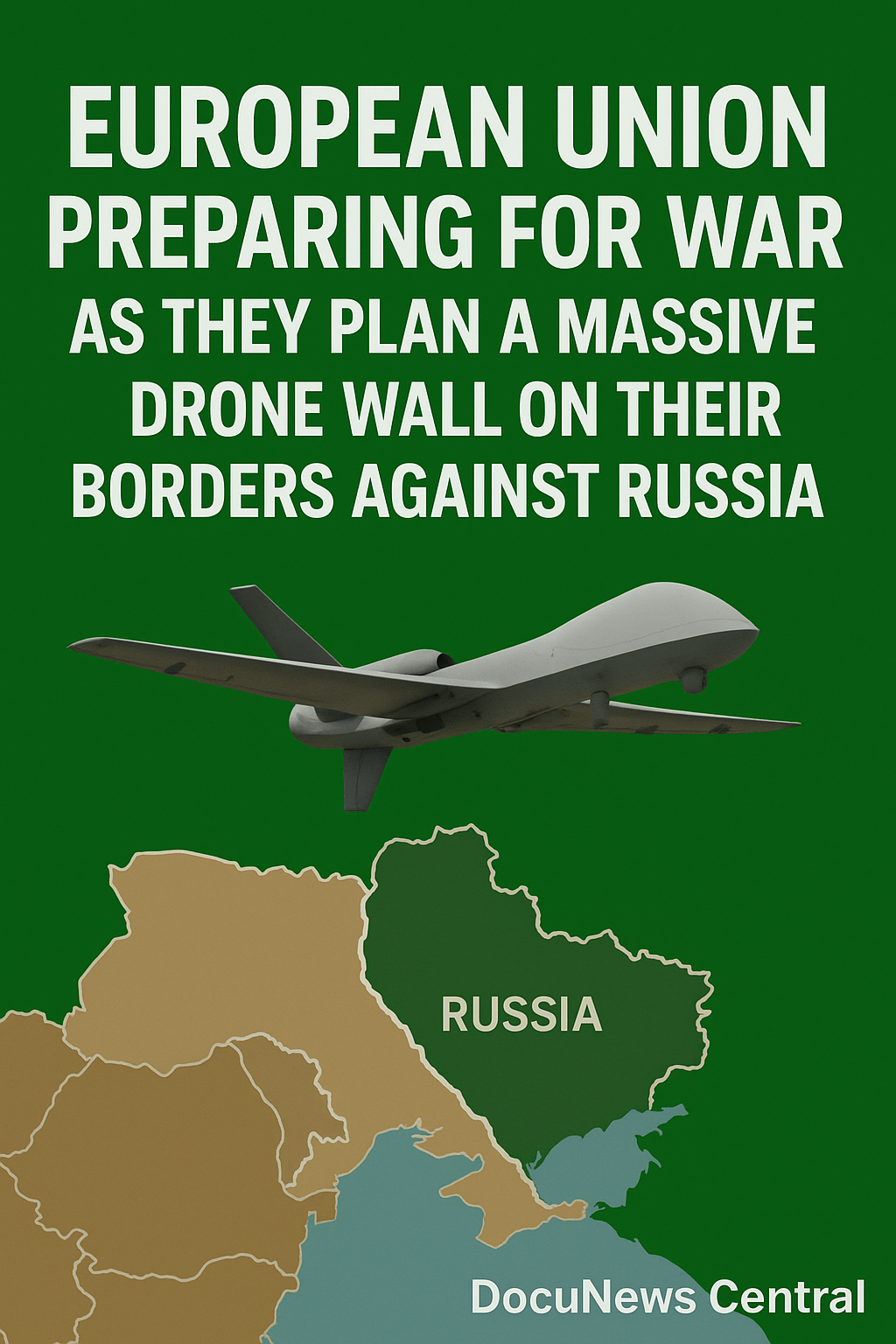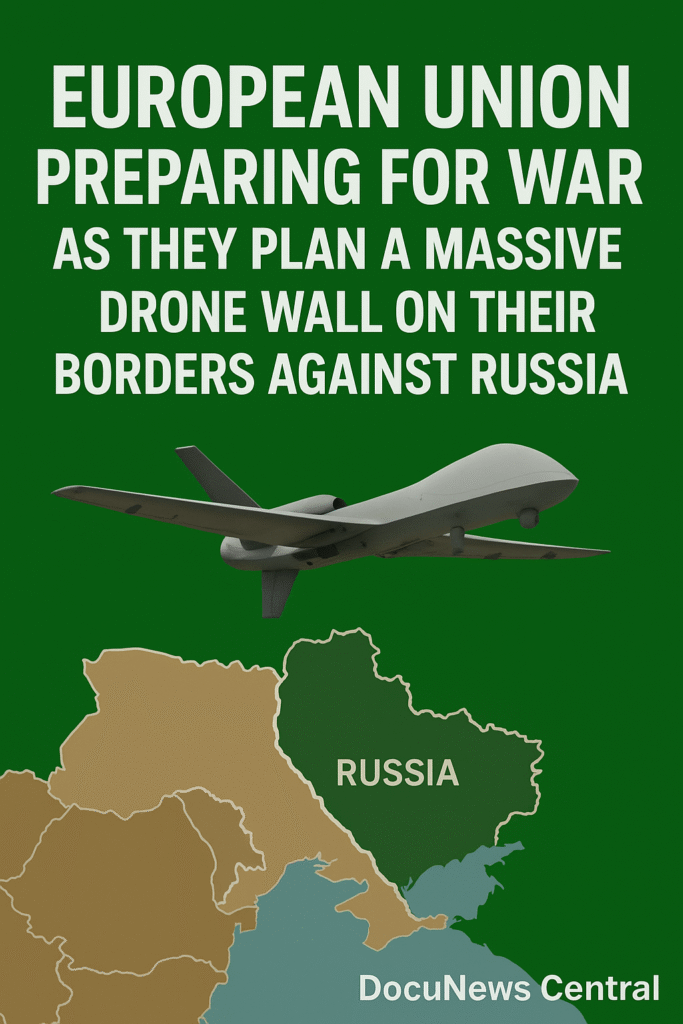

EU Plans Massive Drone Wall to Shield Eastern Borders from Russia and Ukraine Airspace Threats
The European Union (EU) has announced a bold plan to build a “drone wall” along its eastern borders to counter growing airspace incursions from Russia. This unprecedented project aims to protect member states bordering Russia and Ukraine from the increasing threat of unmanned aerial vehicles and other airborne security risks.
The initiative comes amid mounting tension between Russia and the West, with several recent incidents of Russian drones and aircraft entering European airspace. Nations such as Denmark, Poland and Romania have all reported serious breaches that triggered emergency responses and heightened fears of potential escalation.
Urgent Action After Repeated Russian Airspace Violations
Over the past year, the frequency of Russian drone flights near EU borders has risen sharply. Denmark, Poland, and Romania, in particular, have reported several unidentified drones and aircraft skirting or even breaching their national airspace.
Military experts say these incursions may be testing European defences and probing for weaknesses. In some cases, fighter jets have been scrambled to intercept the intruders. While no major damage has been reported, the repeated nature of the incidents has alarmed both EU governments and NATO allies.
Officials warn that Russia’s tactics are designed to intimidate and possibly to collect intelligence on Europe’s air defences. The proposed EU drone wall is therefore seen as a strategic shield against such actions, providing early detection and rapid response capabilities.
High-Level Meeting to Kickstart the Drone Wall Project
The European Commission hosted the inaugural meeting for the drone wall project on Friday, bringing together a coalition of key member states.
Countries represented included Bulgaria, Denmark, Estonia, Hungary, Latvia, Lithuania, Poland, Romania, Slovakia, and Finland. Notably, Ukraine also participated, reflecting the country’s vital role in regional security.
The meeting was chaired by EU defence commissioner Andrius Kubilius, who called the move an “immediate priority and a core element to protect against incursions from the skies.”
“Russia is testing the EU and NATO, and our response must be firm, united and immediate,” Kubilius said after the virtual session. His words underline the urgency with which the EU views the situation.
A Central Pillar of the Eastern Flank Watch
The drone wall is a key component of a wider EU security framework known as the “Eastern Flank Watch.”
This comprehensive plan also envisions a ground wall and a maritime wall, designed to strengthen defences on land and at sea in addition to the skies.
The drone wall will focus on detection and intervention. By deploying state-of-the-art radar, surveillance drones, and counter-drone technology, the EU hopes to create a continuous protective belt across its eastern frontiers.
One Year Target, but Timeline Still Uncertain
According to Commissioner Kubilius, initial estimates suggest that the drone wall could be built in about one year.
He explained that a detailed conceptual and technical roadmap is already in development. This plan will be drawn up at a follow-up meeting of envoys from the participating countries, alongside industry representatives and Ukrainian officials.
However, Kubilius also cautioned that the one-year target is only a preliminary estimate. He admitted he is “not very convinced of the timeframe given,” signalling that the project could face delays due to its complexity and cost.
The EU leadership will further discuss the plan during a summit in Copenhagen next week, and again in October when leaders meet in Brussels.
Why a Drone Wall Is Critical for Europe’s Security
The idea of a drone wall might sound futuristic, but security analysts say it is a logical response to modern warfare tactics.
Drones are now a central part of military and espionage operations, used for surveillance, data collection, and even delivering explosives.
Russia’s recent military actions in Ukraine have demonstrated how cheap but effective drones can be deployed for reconnaissance and attacks.
For the EU, whose eastern members share long and often remote borders with Russia and Ukraine, traditional air defence systems alone are no longer enough.
A drone wall would allow continuous monitoring, giving border countries early warning of suspicious activity and the ability to neutralize potential threats before they escalate.
Member States Unite for Collective Defence
The involvement of ten EU countries plus Ukraine shows the regional scale of the project.
Countries like Poland and the Baltic states—Estonia, Latvia and Lithuania—are on the frontline of tensions with Russia. They have repeatedly urged the EU and NATO to strengthen eastern defences.
Finland, which shares a long border with Russia, has recently joined NATO and is now a key player in the EU’s security strategy.
By pooling resources and intelligence, these countries hope to build a defensive barrier far more effective than any single nation could achieve alone.
Collaboration with Industry and Technology Leaders
To make the drone wall a reality, the EU will work closely with private-sector technology companies that specialize in radar systems, drone detection, and counter-drone weapons.
This partnership aims to ensure the wall is built with cutting-edge technology, capable of spotting even small, low-flying drones that are often difficult to detect with traditional radar.
Advanced systems such as radio-frequency sensors, infrared cameras, and AI-powered tracking software are expected to play a major role.
Experts say the EU will also need to invest in rapid-response units that can intercept or disable hostile drones using tools such as jammers or laser weapons.
Challenges: Funding, Coordination and Legal Framework
Despite strong political will, the project faces significant challenges.
First, the financial cost is expected to be high. Building a multi-country aerial defence system requires not only hardware but also maintenance, personnel training and long-term operational funding.
Second, coordinating efforts across ten EU nations and Ukraine will be complex. Each country has its own security protocols, military capabilities and legal frameworks.
Experts also warn that the EU must establish clear rules of engagement. For example, when a suspicious drone is detected, who has the authority to take it down, and under what conditions?
Russia’s Likely Reaction and the Risk of Escalation
Moscow is unlikely to welcome the EU’s drone wall plan. Russian officials have previously criticized NATO’s military buildup near its borders as provocative.
Analysts predict that the Kremlin may view the drone wall as yet another Western attempt to contain Russia, potentially leading to further diplomatic tension.
However, EU leaders argue that the wall is a defensive measure, aimed only at protecting European airspace and preventing accidental or deliberate incursions.
Link to Recent Incidents in Poland and Romania
The urgency of the project is reinforced by recent incidents in Poland and Romania, where Russian drones and missiles from the war in Ukraine have strayed into NATO territory.
In some cases, airspace was temporarily closed and fighter jets were scrambled to prevent potential attacks.
These events highlight how quickly a regional conflict can spill over into EU territory, making a permanent surveillance and defence system an urgent priority.
What Comes Next
The next few weeks will be critical as EU leaders debate the details of the project.
At the upcoming Copenhagen summit, member states are expected to finalize a political commitment to the drone wall and discuss funding mechanisms.
In October, a second round of talks in Brussels will focus on the technical roadmap, including which technologies will be deployed and how the wall will be staffed and operated.
A Turning Point in European Security
Security experts say the drone wall represents a major turning point for the EU’s defence strategy.
Until recently, the European Union has relied heavily on NATO for its military security. But the war in Ukraine and growing Russian aggression have pushed the EU to take greater responsibility for its own protection.
The drone wall is therefore seen not only as a practical defence system, but also as a symbol of Europe’s determination to safeguard its sovereignty and territorial integrity.
Long-Term Vision: From Defence to Deterrence
Ultimately, the EU hopes that the drone wall will not just protect against incursions, but also deter Russia and other potential adversaries from even attempting such actions.
By demonstrating that Europe can detect and neutralize any aerial threat, the EU sends a powerful message: its borders are secure and well defended.
The European Union’s plan for a drone wall marks one of the most ambitious security projects in its history.
If completed, it will stand as a high-tech shield stretching across thousands of kilometres of Europe’s eastern frontier.
While challenges remain—from funding to coordination and potential Russian backlash—EU leaders are clear that the cost of inaction is far greater.
As Commissioner Kubilius warned, “Russia is testing the EU and NATO. Our response must be firm, united and immediate.”
The coming months will show whether Europe can turn this bold vision into a functioning reality—and whether the drone wall becomes the new backbone of European security in an era of rising geopolitical threats.
docunews Central Reporting.








